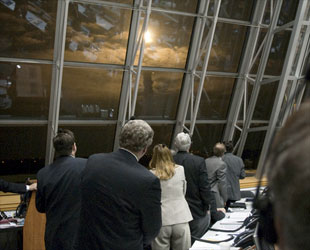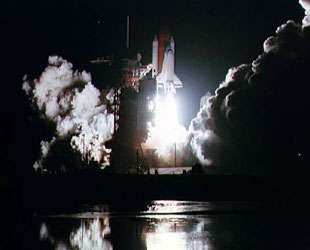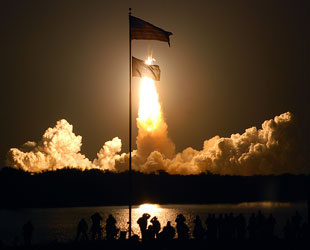February 8, 2010 — Space shuttle Endeavour pierced the pre-dawn sky over Florida on Monday, creating an artificial sunrise for what is expected to be the last time. With just four shuttle missions remaining after the current STS-130 flight, all are currently scheduled to launch during the day.
Endeavour
set the sky ablaze at 4:14 a.m. EST, starting its 13-day mission to the International Space Station (ISS) to deliver the
Tranquility Node 3 module and its adjoining Cupola observation portal. The launch was delayed a day due to a low cloud ceiling over Kennedy Space Center.
STS-130 commander George Zamka spoke about his and his crew's nighttime spectacle in a pre-flight interview.
"It is going to light up the ground around," he described. "You should be able to see it from as far as the Carolinas, I think, if the skies are clear."
"It should be a wonderful sight," Zamka said.
And so it was, said launch director Mike Leinbach during a post-launch press conference.
"It lit up the Kennedy Space Center. I was looking out the windows of the control center and then looking down at the ground to see how bright it [got], and that's a special, special view," Leinbach described, adding that he saw it through two minutes into flight, when the twin solid rocket boosters separated.

| Launch director Mike Leinbach and other managers watch from the control center as Endeavour launches. (NASA/Kim Shiflett) |
"Then it disappeared behind some clouds and I got kind of disappointed, but then it broke out of those clouds and that was when I was able to see it all the way out to seven minutes in flight, off of Cape Hatteras," he added.
That night-assisted sight has been something of a rarity over the past 29 years of space shuttle launches. Out of the 130 missions flown to date, only 34 have taken to the sky after sunset and before sunrise.
Mechanics over majesty
Though night launches do deliver a sensational view, their scheduling is not influenced by their spectacle. Rather, it's orbital mechanics that dictates the time of day... or night.
Endeavour's mission is to rendezvous and dock with the ISS, which requires the two spacecraft to align in orbit. To do so, as NASA spokesman Mike Curie explains, the two need to align on Earth, too.
"It has to do with the phasing of the orbit and the fact that as the space station rotates around the Earth, it passes over different points of the Earth each orbit," he said. "The shuttle launches when the station is in the same orbital phase with Kennedy Space Center."
NASA could just target dates when that alignment occurs during the day -- or night -- as desired, but the agency has a more important concern: launching missions when they are ready to fly.
"Soon as the crew is trained and the vehicle is ready, we want to launch," continued Curie, "so we establish a date and then we look for what time the space station is going to be in the orbital plane on that day, and on this particular day [for Endeavour], it happens to be in the middle of the night."
For missions launched prior to the space station, or which were headed elsewhere, the same reasoning applied, just for different orbital targets.
Night flights by the numbers

| Space shuttle Challenger lifts off on the first night launch of the shuttle program, STS-8 in 1983. (NASA) |
The first shuttle night launch took place on Aug. 30, 1983 at 2:32 a.m. EDT as Challenger began the STS-8 mission. Instead of rendezvousing with something already in orbit, the mission was to deploy an Indian telecommunications satellite, which tracking requirements dictated a particular orbital plane.
The STS-8 crew, led by commander Dick Truly, prepared for the night flight by training in darkened simulators but it turned out to be for naught.
"It was like the inside of a bonfire," reported the mission's pilot Dan Brandenstein of the lighting experienced inside the crew cabin during liftoff.
Truly, who previously piloted the shuttle's second mission, a day launch, compared his earlier ascent with STS-8's.
"The light from the [two side-mounted] solid rocket motors was about 500 times more than I remember on STS-2," he told flight controllers.
STS-8 marked the only night launch for Challenger, which was lost in flight three years later on STS-51L.
Columbia, the first orbiter to fly, logged three of the shuttle program's 34 night launches, including the STS-109 flight to service the Hubble Space Telescope. It too was lost in flight on its very next mission, STS-107 in 2003.
Discovery lit the evening sky nine times, most recently in Aug. 2009 on the STS-128 mission.
The most night launches were logged by orbiter Atlantis at 11 flights starting with STS-61B in 1985 through STS-104 in 2001.
Endeavour recorded ten in total, including the first shuttle flight to the International Space Station, STS-88 in 1998.
Of the four launches left for the shuttle program, STS-134 -- the last flight of Endeavour -- has the greatest chance of slipping into the night. Were weather or technical issues to delay that July launch by about a week, then its liftoff would occur before sunrise.
For now though, STS-130 is the last of the night flights.
"For the last night launch, it treated us well," expressed Leinbach. "I think everybody appreciated it."



